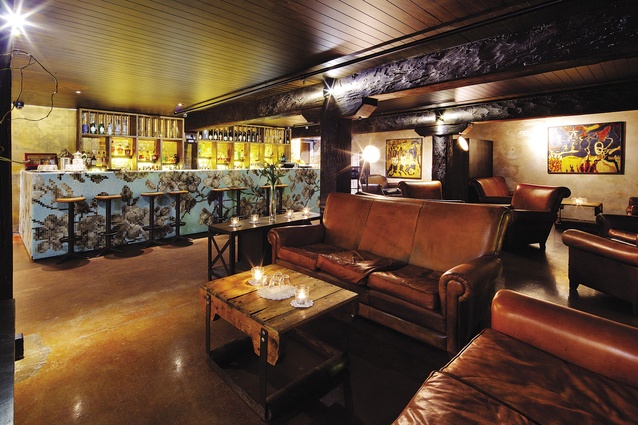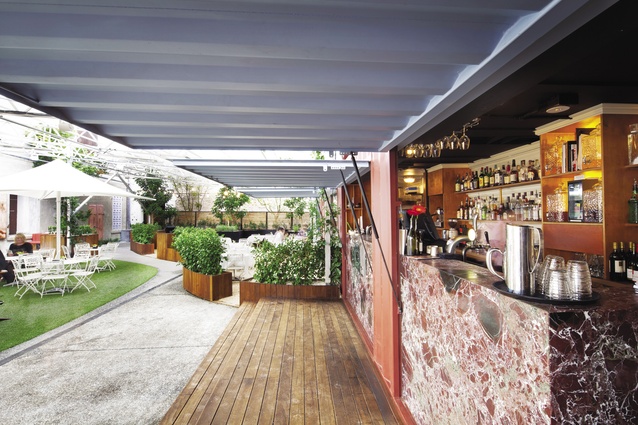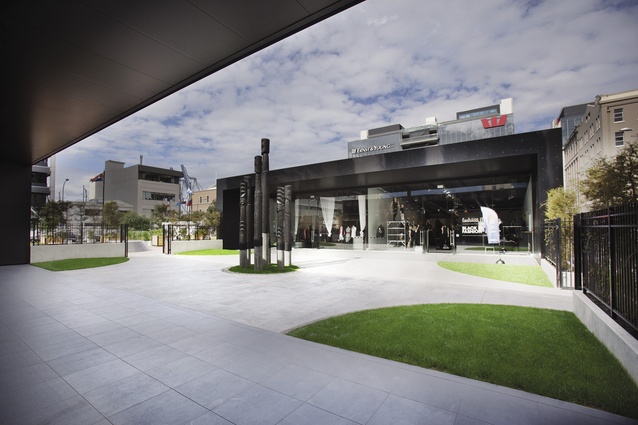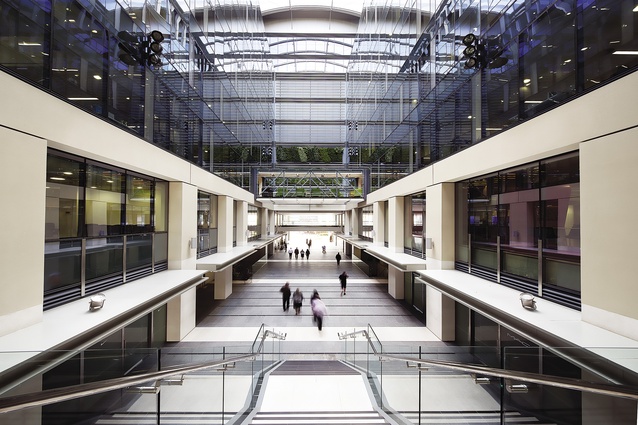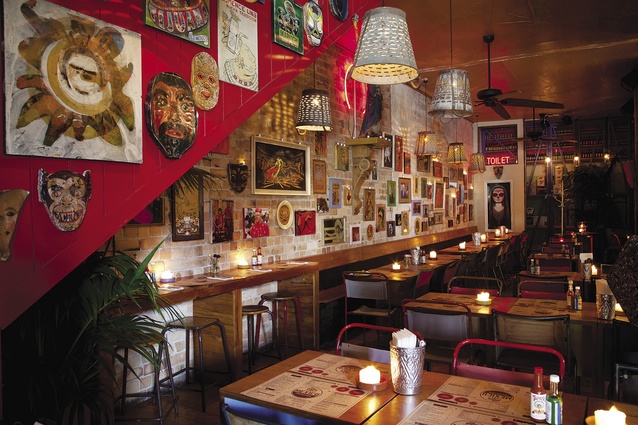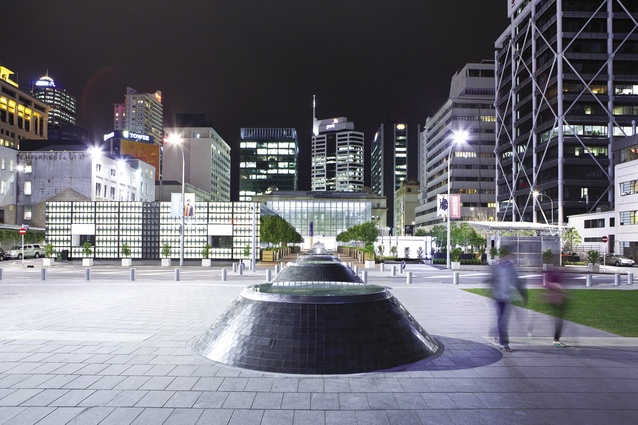Britomart Precinct
Along with the Wynyard Quarter, the development of Auckland’s Britomart Precinct is paving the way for the city’s renaissance. In Part 1, Nat Cheshire escorts us around the neighbourhood. In Part 2, Bill McKay reviews the regeneration of the area and questions its future.
PART 1: Journey into Britomart
Much architectural criticism occurs in a vacuum, as if architecture were the pure expression of a designer’s will. In the city, a huge number of forces shape what becomes known as architecture. Architecture here is a political act and, as such, it benefits from explanation.
Auckland’s Britomart precinct has one owner, determined by civic competition. That owner, Cooper and Company, is mandated by the city to develop the precinct. In return, Cooper and Company is entitled to draw rental income from its tenants. Essentially it’s a lease between city and developer but there’s a catch: In 100 years, the city gets everything back, for a dollar.
A deal like this requires commercial sustainability. The desire for immediate profit must be suspended in favour of long-term growth. The developer must seek out the best tenants and operators of this city, empower them to embrace Britomart as their own, and nurture here a collective ambition for a dense, delight-full and dynamic new part of the city. It is on the back of this shared energy that Britomart’s rehabilitation has commenced.
What follows is not an architectural critique of Britomart. Others may undertake this more dispassionately. Nor is it a guide to the heritage of Britomart. Others are better disposed to that task. This is a short, biased walk. At each stop, it seeks to illuminate the forces that have helped shape that place and how those places might, in turn, shape the future of this city.
Any journey through Britomart must begin by train. Five years ago, the train station was pitiful. A lonely man barely made his living selling coffee to the four commuters passing the station’s gates each morning. Catch the 8:25am from Morningside now and spend the trip squeezed into the aisle. Be swept through the doors and up the heaving platform into the light. The conversion of Central Post Office to train station is brilliant: the old CPO has as grand an air as this city might offer. The glass pavilion added to its east transcends prosaic modernism, filling the station with light and appearing as a lantern to the precinct beyond.
Above us are offices, as in almost every old building here. They’re special – big old windows, age-worn structures and soaring ceilings. Walk through the pavilion, flanked by Michael Parekowhai’s tall silver sculptures and into the city. Ahead gleams the polished chrome of an Airstream trailer. This is the smallest food outlet in Britomart. Its muesli is handmade by a young woman who owns four restaurants and its Valrhona afghan cookies by a young man who owns 11 bars. Despite the scale of their businesses, they make these by hand before the sun rises each day. They do this not because it makes the Airstream successful – it’s too small for that – but because it makes Britomart successful.
Beyond lies a clutch of ‘pop-up stores’ – temporary retail space for the incubation and testing of new brands. The best of these is a cute little shoebox of a shop for Kathryn Wilson. Another glint of silver bookends this block: a sleeve of aluminium mesh shrouds a valet station. Inside are dressing rooms of polished mahogany and mirror, complete with hair dryers and straightening irons. The valet is intended to provide a gracious welcome to Britomart’s visitors. It does not make any money. Instead, like the young woman making muesli, it makes Britomart – and every business in it – just a little more enticing.
Immediately to the south are two large, black mesh boxes whose sheer walls glow softly at night. These are retail showcases, developed for tenants more interested in enticement than exposure. Between them is a sheltered courtyard focused around an imposing family of Pou Tu Te Rangi, sculpted by Chris Bailey.
The showcases exhibit the speed of their assembly in the standardisation of their parts. This is a 1,000-m2 project that was constructed in nine weeks. Britomart’s leasing team nurtures its relationships for years, but they must measure the time frames of their deals in weeks. Opportunities here are fleeting and projects turn on an overnight sketch. David Mitchell famously announced that if you couldn’t redesign the city in half an hour, you’d never do it. It seems he was right.
Slip between the black boxes and out onto Galway Street. To the right is the converted Levy Building, ahead the conjoined Stanbeth and Excelsior Buildings. Levy’s beautifully weighted lobby arrests decades of flaking paint and crumbling plaster. This patina is played off against polished timber and new stone. The resultant tension of ‘raw and cooked’ efficiently delivers rich, character-full space from elegant but dilapidated old buildings.
Cross the street to the Stanbeth and Excelsior buildings. Into these immutable old structures have been slipped highly serviced hospitality and office environments. Step inside 1885 Britomart or Cafe Hanoi; they play with the same tensions as does Levy but the richness and humility of age here is spiked with intermittent luxuries to dramatise the social performance of hospitality.
Pop around the corner for pikelets at the Shaky Isles café and you’ll see the results of the most substantial heritage rework in the precinct. The old rhythm of these façades has been re-established from grainy photos, new arched windows soar in the space and outside the buildings seem returned to glory, blighted only by the ugly bucked teeth of the usual civic bus shelters and the gaseous breath of their buses.
Cross Customs Street and take in the century-old, block-length façade. How many of these survived the wrecker’s ball of the free-wheeling ’80s? To the east, the Buckland and Masonic buildings – peculiar for their matching façades that conflate two buildings into one – have been painted in green, gold, ivory and crimson. The whole block has been unified by restored parapets. This time around these are crafted from lightweight GRC: the original builders had not anticipated the risk their heavy masonry crowns posed in these shaky isles and, after Napier’s earthquake, they were torn from rooftops across the city in a frenzy of self-preservation. Even decorative capitals and roundels were considered projectile risks and Buckland and Masonic still bear the lumpy scars of their removal.
Look back at Excelsior: its unusually slender profile is a result of a 1930s’ amputation, when half the building was carved off to broaden Commerce Street. Read the big old loading-dock doors and carefully preserved mouldings against the crisp new incision down the middle of Excelsior’s Commerce Street façade. Here, the heritage architects have empowered the telling of history as a continuous and inclusive story.
Visit the Masonic Building’s Made Boutique to see Britomart in the nude, complete with beautiful herringbone struts, then seek refreshment around the corner in the Britomart Country Club. An old tin annex used to sit on this site, pulled down years ago to free up development space and open up the big, old brick buildings around it. Those buildings had an interim layer of work applied to their interiors, making them safe for interim occupation. Then, in moved creative offices and studios supported with small, short-term rents. Their presence, in turn, delivered people, life and creative force to an otherwise desolate precinct. The empty site was used for car parking, generating a little cash flow while development was being planned. A handful of retailers were helped into the ground floors, livening up the street edge and taking advantage of the big volumes and rich, raw building fabric. The Britomart Country Club (BCC) emerged almost overnight: a bunch of shipping containers dumped on the old car park, enfolding a secret garden.
Once BCC appeared, the old walls around it seemed too unruly to bear. A tangle of PVC plumbing was consolidated into neat copper risers. A meandering line was traced across the Buckland-Masonic wall and everything below that stripped back to raw brick and plaster. This delineates the ghosted form of the annex that once stood on the site. It describes its absence. Above the line, the façade plaster was repaired and re-finished with lime paints that will soften with age. At ground level, blocked-in windows were uncovered and smashed out; one now looks from BCC right through a whole building and out into the city. It’s this wall that now delivers the urban ‘tooth’ that offsets BCC’s levity.
In a couple of years, BCC will be picked up and moved away: this is a development site with the rare potential to deliver height to the precinct. Once that next project starts, Buckland and Masonic can be more comprehensively developed. The incremental development of the site and of Britomart will continue. Taking one step at a time maintains an adaptable position that is responsive to the changing forces of the city, educated by the outcomes of each move and continually repositioned as new opportunities arise. Malls are developed all at once. Cities are grown.
Over the road are the Australis and Nathan buildings. It is telling that such good, big buildings remain undeveloped. Cooper and Company has started small and is working up towards its giants.
The first heritage projects in Britomart were single buildings, picked for their critical corner locations and manageable scale. Next, medium-scale buildings were conjoined, consolidating upper-level circulation into efficient cores, and their ground floors separated into collections of mutually reinforcing smaller tenancies, delivering diversity and tooth to the street edge. When they finally swing into action, the biggest buildings will benefit from every move preceding them. They will be populated by the increasingly powerful and sophisticated tenants which are attracted by this now-thriving precinct.
Australis and Nathan are thrilling for the potential they hold. Australis and Nathan front the southern edge of Takutai Square but it is the huge new Ernst & Young (E&Y) building that structures it. The day it opened, E&Y delivered thousands of people to Britomart, streaming in and out of its lofty offices and street-level retailers. That so many of these people arrive by dedicated exit from the train station makes it even better. Alongside E&Y, linked by air bridges over Galway Street, is the new Charter Customs Building. Across Britomart Place, at the easternmost point of the precinct, is the lavish Britomart Car Park.
These buildings play a crucial role in the delicate economic ecosystem of Britomart. Their scale and efficiency mean they will offer the greatest potential incomes to the precinct. To maximise that potential, however, they need to attract great tenants. To attract great tenants, they need more than scale and efficiency. They need character and amenity. Britomart’s carapace of heritage conversions delivers both but their restoration comes at such enormous cost that they are scarcely tenable as individual developments. Thus emerges a system of mutual reinforcement, whereby the stability and income of big business is carefully balanced against the excitement and diversity of the boutique.
Between the Nathan Building and Charter House is Roukai Lane. Roukai Lane is an invention. It was shaped after close study of the best alleyways in the city. There used to be a little factory building here – one of its old posts still stands at the Customs Street entrance. An outdoor fire warms the leafy, cobbled alley and a den called Racket Bar does an incredible job of helping you forget you’re in a new, curtain-walled office building. It’s a stage setting and it’s no less intoxicating for that. So what if modernism proclaimed honesty?
Further up the block, tucked into a corner of Charter House, is the old Kiwi Tavern building. The ebullient Mexico occupies the ground floor. It’s the newest fit-out in the precinct, and the cheapest, and it always seems the busiest. Mexico is the latest venture of the biggest hospitality operators in Britomart. As such, it is peculiar for its humility. It reminds us that bigger and grander is not the only trajectory of the successful.
Emboldened by tequila and $6 tacos, continue down Britomart Place and into Tyler Street. Tyler Street is ugly. It’s a service street. Its few heritage buildings are interspersed with concrete monoliths and old sheds. It is all the more exciting for this. In a precinct luxuriating in old brick and waxed kauri, the ugliness of projects like the Seafarers conversion and Tyler Street Garage is exhilarating. In this part of the precinct, you realise that ugliness is as important as beauty, and they are separated by only a hair’s breadth.
There’s also the promise of depth here. Cities are never defined just by their street edges. There’s only so much people will be shown before they want to start discovering for themselves. Tyler Street Garage’s beautiful rooftop hideaway and the dark, concealed world of Ebisu suggest that there’s always something else worth hunting for.
Ahead, at the crossing of Tyler and Gore Streets, lie the Northern Steamship and Maritime buildings. In many ways, the new Britomart started here. These were the first converted buildings. The Northern Steamship Company was the first brave bar to open in an otherwise windswept wasteland. It seemed a miracle that anyone showed up but they did. Sitting here now, crammed between happy revellers, it takes effort to recall quite how tough that beginning was.
Britomart always threatened to transgress its boundaries, infecting the city with its optimism and new-found density. Already, brilliant projects like Imperial Lane are capitalising on Britomart’s explosion, and streets like Fort, Commerce and Customs are alive with refurbishment and new eateries. Between the Maritime and Seafarers Buildings, a continuous strip of establishments now open onto Quay Street. In doing so, they exhibit a confidence that one day, not far from now, the weight of the metropolis will leap that broad street and carry our city to its sparkling water’s edge. Auckland will be unrecognisable. This is the greatest promise of Britomart. Nat Cheshire.
PART 2: The rise and fall of Britomart
What has happened to Auckland, we ask ourselves, as we are spoiled for choice for Friday drinks’ venues at Britomart, then drag the kids around North Wharf on the weekend. It’s like a proper city, almost as good as an Australian one. Apart from the high standard of bar design, Britomart has been endorsed by the fashion world too, with many in the process of moving their shops from High Street; truly the end of one era and hopefully the beginning of the next. And, of course, the new high-rise to the east is filling up, from the retail in its atrium to the office levels above: banks and insurance companies for now but the lawyers can’t be too far away. Which suggests a possible problem, aside from an invasion of loud men in suits.
One of the attractions here is the low-rise centre of the precinct but that is not to last, apparently. Another large office block is planned for that spot and there may well be more on the periphery along Quay Street. The current pop-up shops, mostly fashion, occupying the centre of the precinct are temporary, planned to last a few years at most. As we have seen from parts of Christchurch, this can be a boon when they are mostly experimental or ad hoc, such as the Britomart Country Club, giving the place a fresh and edgy, stylish vibe that’s more adults’ playground than staid retail streets. But, as we know in Auckland, the bigger a building gets, the more boring it is. I worry that high-rise development in the heart will erode this spirit, and I worry even more that a big building will split that large precinct in two and eradicate the lovely afternoon sun that fills the place.
Commerce Street and the area east of the Transport Centre needs better definition but I’d rather see the high-rises located more around the periphery, even if it means a few along Quay Street. That could set up a nice tension with the waterfront. Mind you, I don’t want to see the old Schooner Tavern/Seafarers Centre go. That’s a crisp piece of modernism (now endorsed by Zambesi, World and co) and one of the beauties of Britomart is the layering of heritage buildings, not just 19th century and early 20th but ’50s and ’60s too. Tyler Street Garage with its rooftop terrace is great fun and the best bars and restaurants round here are in retrofitted buildings that provoke all sorts of possibilities. But this building is planned to go as well; fingers crossed the recession lingers, booms are always bad for Auckland’s architectural heritage.
And, lest we forget, Britomart is all artificial land; a vast dirt tray created when the original Britomart bluff, including pa site, historic spot where the British flag was first raised, the eponymous fort and St Paul’s Church, were all tipped into the harbour in the name of commerce and industry, one of Auckland’s first major acts of environmental vandalism. These ‘reclamations’ have ruined the bay and ridge rhythm of our historic shoreline and we have a long, flat foreshore mostly devoted to the port and cars. That has to change. With the success of North Wharf and the future high-density housing in Wynyard Quarter, we need to make a virtue of our newish topography and strengthen pedestrian and public transport, not just buses but trams and light rail all along the waterfront axis from North Wharf through Britomart to Vector Arena, then on to the Parnell Pool and off around the eastern bays. Only public transport like this can reliably handle the choke points like Quay Street through which we persist in trying to push cars. It also means we don’t continue to waste decent inner-city space on car parking.
On my wish list, as well, is the undergrounding of Quay Street to improve pedestrian links north from the city across to the waterfront; it’s happening in cities all over the world. But we are still doing stupid things, such as we see in that tragic block to Britomart’s east. That quarter-kilometre-long wall of the Scene Apartments, which turns its ugly, fat arse to the city and blocks out harbour views and pedestrian access, is at least a decade old but new tragedy has recently unfolded here in the form of a supermarket and car park. Who, in this day and age, builds car parks and supermarkets on the harbour edge? There is a kilometre of suburban sprawl beyond this; industry, fast-food joints and a strip reminiscent of the outskirts of some hick town, yet right on the shore of one of the most wonderful harbours in the hemisphere. If our Council is serious about creating one of the world’s most liveable cities then they are going to have to employ some vision, some arm-twisting legislation and some high explosive. And, that port can’t get any bigger either; we are better off with Tauranga serving the city from the south via heavy rail. So, we have a long way to go but, meanwhile, all those behind North Wharf and Britomart deserve a pat on the back; they are starting to show us the way. Bill McKay

